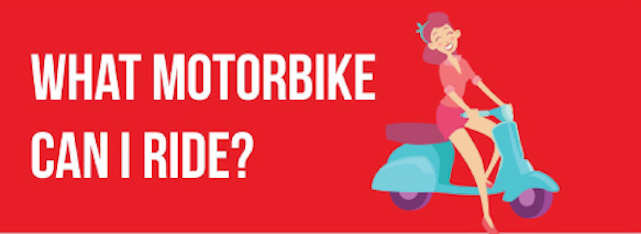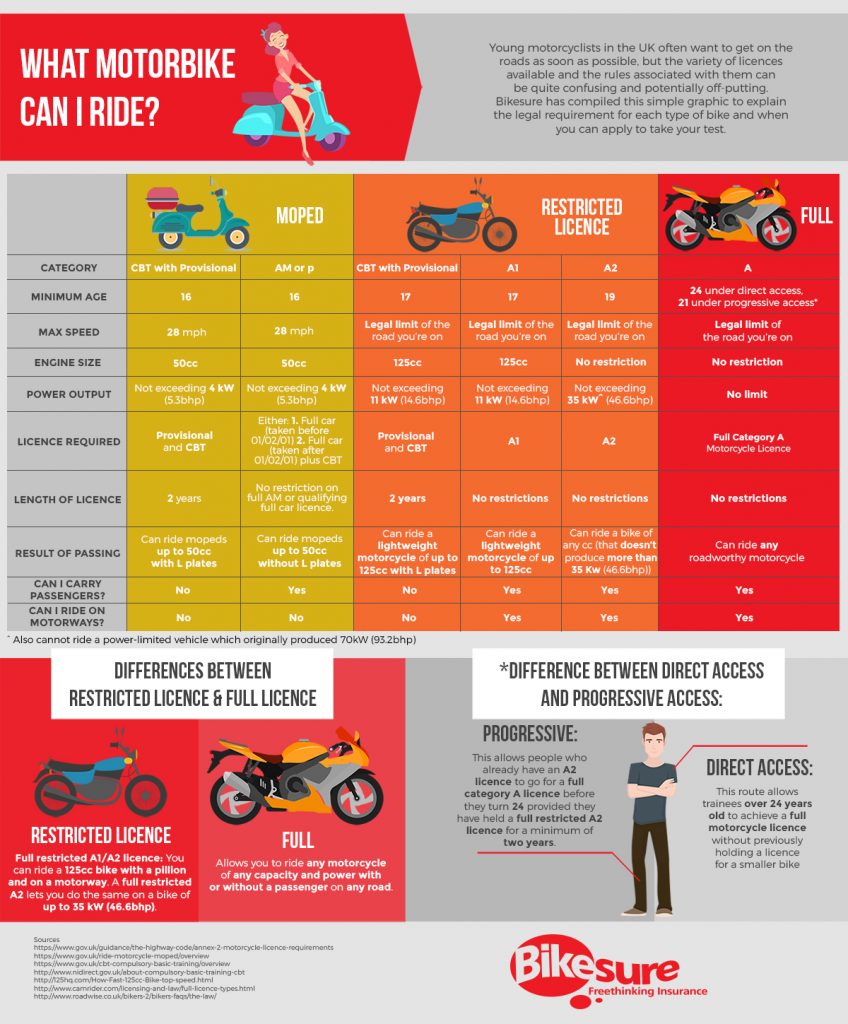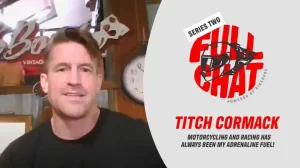What motorbike can I ride?

Whether you’re eagerly anticipating your 16th birthday to get on your first bike or getting into motorcycling at a ripe old age, figuring out which licence you’ll need can be confusing.
There are different rules based on what kind of motorcycle you want to ride, how old you, are and your experience level. When you add in constraints around maximum power output, carrying passengers, and terms like direct and progressive access, it’s easy to see why a lot of first-timers find it baffling.
This blog explains which motorcycles you can ride, the driving licences you may need to hold, and what driving tests you need to take.
Bikesure has also compiled this simple infographic to explain the legal requirements for each type of bike and when you can apply to take your test.
Infographic: what motorbike can I ride?

Click to Open
What type of motorcycle licence do I need?
Knowing which motorbike licence you need is complicated and, as the infographic shows, dependent on several factors. The approach is called ‘staged access’. For example you may be above a certain age, but not have passed certain tests or completed certain training, and this can impact what you can ride.
Here’s a guide to the different licences you can hold:
Provisional Licence
You must have the right provisional driving licence when you’re learning to ride. You can apply for a provisional licence if you’re at least 15 years and nine months old and can read a number plate from 20 metres away.
Your vehicle must have a valid V5C registration certificate (log book), be taxed, have an MOT (if needed) and you will need adequate motorcycle insurance.
If you are 16 or over and have completed your Compulsory Basic Training (CBT),you can ride a moped up to 50cc with L plates for two years (after which you must retake the CBT or take a practical test).
If you are 17 or over and have completed your CBT, you can ride a motorcycle up to 125cc with L plates for two years (after which you must retake the CBT or take a practical test).
You must have the right provisional driving licence when you’re learning to ride. You apply for a provisional licence if you’re at least 15 years and nine months old and can read a number plate from 20 metres away. Your vehicle must have a valid V5C registration certificate (log book), be taxed, have an MOT (if needed) and you will need adequate motor insurance. Get a motorcycle insurance quote here.
If you are: 16 or over and have completed your CBT.
You can: ride a moped up to 50cc with L plates for two years (when you must retake CBT or take a practical test).
If you are: 17 or over and have completed your CBT.
You can: ride a motorcycle up to 125cc with L plates for two years (when you must retake CBT or take a practical test).
AM Licence
If you are 16 or over and have completed the CBT, a theory test and the practical test,you can ride a moped (scooter or motorcycle-style) up to 50cc with a top speed of 28mph without L plates. You may also carry a passenger.
A1 Motorcycle Licence
If you are 17 or over and have taken a two-stage practical test, after completing your CBT and passing your theory test,you can ride a motorcycle or scooter up to 125cc without L plates and to carry a passenger. It is worth noting at this stage that passing a full motorcycle test can help reduce your insurance costs.
A2 Motorcycle Licence
If you are 19 or older and have held an A1 motorcycle licence for more than two years, you can take another practical test and, if you pass, receive your A2 motorcycle licence.
If you are 19 or older and don’t already have a licence, you can complete CBT and pass the theory and practical tests to get your A2 motorcycle licence.
This licence type will allow you to ride a motorcycle up to 35kW (49.6bhp).
Unrestricted A Motorcycle Licence
If you are 21 or older and have held an A2 motorcycle licence for two years, you can take another practical test and get an unrestricted A motorcycle licence.
If you are 24 or older and don’t already have a licence, you can complete the CBT, and pass your theory and practical tests.
Once complete, you will be able to ride any motorbike or scooter without L plates and carry a passenger.
What if I already have a car licence?
If you passed your driving test on or after 1 February 2001 you can receive a full moped licence if you complete the CBT. Alternatively, you can complete the CBT then pass your car driving test within two years. This will allow you to ride a 50cc moped without L plates as long as your car driving licence lasts.
If you passed your driving test before 1st February 2001, you can ride a 50cc moped without L plates and without taking the CBT or the full moped test. However, you must do CBT if you want to ride anything larger than a 50cc moped.
What are the moped and motorcycle tests?
After completing your CBT you can apply to take your full test whether on a moped or a motorcycle. The main difference between the two tests is that the motorcycle test includes the aspect of gears, while the moped test does not – the vehicle being ungeared or twist-and-go.
Motor tricycles or trikes
You can ride a trike of any power rating if you’re over 21 and have a full car driving licence.
Provisional category B car licences and provisional category A licences only cover you to ride motor tricycles if you have a physical disability. Driving tests for three-wheeled vehicles are only available for physically disabled drivers.
If you’re not physically disabled and want to ride a motor tricycle, you’ll now need to get the right provisional entitlement and pass the CBT.
Bike categories, ages and licence requirements
Licence category
Vehicles you can ride
Requirements for licence
Minimum age
AM
Mopeds with speed range of 15-28mph
Compulsory basic training (CBT), theory test, practical test on all powered two-wheeled moped
16
AM
Small three-wheelers (up to 50cc and below 4 kW)
CBT, theory test, practical test
16
AM
Light quadricycles (weighing under 350 kg, top speed 28mph
CBT, theory test, practical test
16
Q
Same as AM plus two- or three-wheeled mopeds with a top speed of 15.5mph
Granted with AM
16
A1
Light motorcycle up to 11kW (and a power-to-weight ratio not more than 0.1 kW per kg) and 125cc
CBT, theory test, practical test
17
A1
Motor tricycles with a power output. Not more than 15kW
CBT, theory test, practical test
17
A2
Standard motorcycle up to 35kW (and a power-to-weight ratio not more than 0.2kW per kg), the bike must not be derived from a vehicle more than twice its power
Direct access route – theory and practical. Progressive access route – two years experience on A1 motorbike and a further practical test
19
A
Unrestricted motorcycles in size/power, with or without a sidecar, and motor tricycles with power output over 15kW
Direct access route – CBT theory and practical (you must be at least 24). Progressive access route – held an A2 licence for a minimum of two years – practical test (21 or over)
24 (direct) or 21 (progressive access)
What is the CBT?
CBT stands for compulsory basic training and involves on-site training and riding as well as driving on the road with the help of a trained guide. Your motorbike instructor will take you through each stage once you have demonstrated basic safety skills at a level they are satisfied with.
Once these have been completed, you will be issued with a certificate (DL196), which will last for up to two years. Learn more about what CBT involves, where you can take it and what to bring with you.
What is the theory test?
The theory test comprises multiple-choice questions and a hazard perception test.
The multiple-choice test consists of 50 questions specific to motorbike riding that must be completed in just under an hour. The hazard perception part of the test consists of videos filmed from the rider’s point of view in which you must identify a number of hazards to pass. The sooner you can respond to a hazard, the higher you score. There is a possible score of 75 and you need to score at least 43 to pass. The test takes roughly 15 minutes.
You will be given your results straight away. If you don’t pass on your first attempt, you can resit the test at a later time. You must pass both sections in order to pass. If you fail one but pass the other, you have to retake both sections before receiving a full motorbike licence. Read our blog to find out more about the theory test.
How much will everything cost?
Read our blog to find out how much a motorcycle licence really costs. And then call the experts at Bikesure on 0330 123 1028 for a motorcycle insurance quote to organise the best cover for you and your machine, whatever licence you have.
You May Also Like …
The Chinese scooters with retro mod style
Buzz1 electric scooter has the look of a vintage Vespa
Motorbikes






